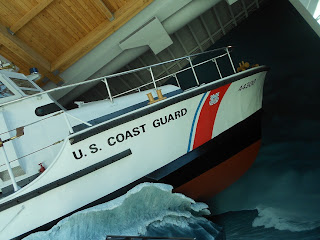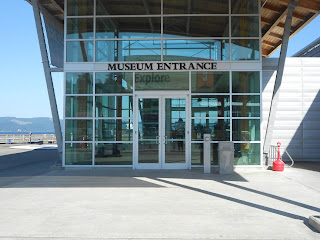 |
| Columbia River Maritime Museum, Astoria Oregon |
The museum contains six galleries and the Great Hall which
showcases the maritime history on both the Columbia River and the Northwest
Pacific Coast. Included are interactive
activities for visitors of all ages. It’s one of the best stops to add to
your Oregon family vacation planner.
The
Treacherous Columbia River Bar
It’s very fitting to have such a large maritime museum in
Astoria Oregon where the Columbia River flows out into the Pacific Ocean. It’s
also fitting because one of the most elite of Coast Guard stations located
there as well. This particular area where the Columbia River meets the Pacific
Ocean sets up a big challenge to shipping. The Columbia River Bar Pilots have long worked the fierce winds and
waves during winter storms. It is at this excellent museum that you can
experience what these ships and bar pilots have encountered over the years. The
Columbia River Maritime Museum
presents this information with photos, artifacts and videos.
What
is the Columbia River Bar?
 |
| Emergency survival enclosure |
The Columbia River
Bar, sometimes just referred to as the Columbia Bar, is a series of shoals
and bars extending about three miles
wide and about six miles long at
the mouth of the Columbia River. The river water is flowing west into the Pacific
Ocean and meets the ocean’s mostly westerly winds. When conditions are just
right, tremendous wave action can occur in just a few minutes. In other words,
conditions can change on a dime. Things can go from bad to worse quite quickly.
This trait alone can make the Columbia Bar very dangerous. The river action
seen at the mouth of the Columbia is unlike any other seen in the U.S. As a
result, the U.S. Coast Guard has seen plenty of action in this area.
United
States Coast Guard Station Cape Disappointment
Cape
Disappointment Coast Guard Station is unique for a variety of
reasons. In addition to being the home of the National Motor Lifeboat School the Cape Disappointment station also
has the task of having to operate in some of the world’s most treacherous seas.
The Columbia Bar is part of a very dangerous coastal area that actually extends
northward to the northwest tip of the Olympic
Peninsula in Washington State. There’s really nothing along either the U.S.
Atlantic or Pacific coast quite like it.
 |
| Coast Guard rescue boat exhibit |
The Coast Guard Station Cape
Disappointment is well equipped. The station boasts five search and rescue
vessels ranging in length from 25 to 52
feet. The station has a complement of about fifty Coast Guardsmen. With these vessels and Coast Guardsmen,
station Cape Disappointment is responsible for search and rescue of both
commercial and recreational vessels in an area about fifty miles north and south from the mouth of the Columbia River. According
to Coast Guard records, the Coast Guard Station Cape Disappointment receives
anywhere from one hundred to two hundred calls a year for assistance. Most of
the assistance activity occurs during the summer months when recreational
boating is at its highest.
The
Columbia Bar Pilots
Just like in harbors all over the world, local ship pilots
take over from the ship’s captain to safely guide the vessel around the local
hazards. The difference with the Columbia Bar pilots is that they work in a
very tricky environment. Columbia River
Bar Pilots number about fifteen. Beginning in about October, the Columbia
Bar pilots have their work cut out for them. This is when the fierce winter
storms begin blowing in from the Pacific and head straight for the river’s
mouth. While recreational boating begins to wind down, the larger ship traffic
continues. Talk about dangers on the job, the bar pilots usually have to board
the large ships by a rope ladder and many times in very heavy seas. The bar
pilots do however have the authority to close the bar crossings if conditions
warrant.
 |
| Coast Guard rescue exhibit showing pilot house |
Avoiding
Accidents at the Columbia Bar
Large vessels regularly transit ports in the Pacific Northwest. Due to their draft and for the most part their limited maneuverability, these large ships must navigate within the dredged ship channel. A good number of accidents happen when a tired crew thinks they can make a bar crossing even though weather conditions aren't right. Smaller vessels must always be cautious and also stay well clear of the large ships. In every instance the Columbia Bar must be crossed with caution. In some instances you might have a tug boat pushing a barge with a pretty large blind spot ahead of it. It's up to the smaller craft to stay well away. The Coast Guard advises small craft to cross the bar during the incoming flood tide and stay on the outer edges of the channel to avoid the large ships.
Capsizings of smaller vessels can occur due to improper loading and/or overloading. This situation makes the small vessel unstable and much more likely to take on water in heavy seas. Coast Guard Station Cape Disappointment reminds boaters to be aware of any warning signs. Warnings are displayed by two alternating amber lights. They appear when seas on the Columbia Bar exceed four feet in height.
Two additional photo articles you will enjoy are the Columbia River's Bonneville Dam and a Visit to the Columbia River Gorge Country.
One of the best things about visiting Oregon are the number of day trips available within an hour or so from Portland. Whether you take a road trip east or west of the city, there are enough interesting and historic stops to fill up a weekend or an entire week. The book below is an excellent source to help plan your Orgon trip.
Two additional photo articles you will enjoy are the Columbia River's Bonneville Dam and a Visit to the Columbia River Gorge Country.
One of the best things about visiting Oregon are the number of day trips available within an hour or so from Portland. Whether you take a road trip east or west of the city, there are enough interesting and historic stops to fill up a weekend or an entire week. The book below is an excellent source to help plan your Orgon trip.
The Columbia River Maritime Museum
The Columbia
River Maritime Museum was the first Oregon museum to meet national
accreditation standards. It is also designated as the official state maritime museum of Oregon. The museum is operated by a private non profit organization established
in 1962 and is funded by membership dues, donations and admission fees. The
Columbia River Maritime Museum has a reputation for the quality of it’s
exhibits and the wide scope of it’s collections. It’s considered one of the
best maritime museums in the U.S. The museum is located at 1792 Marine Drive, Astoria Oregon.
(Photos from
author’s private collection)
.


